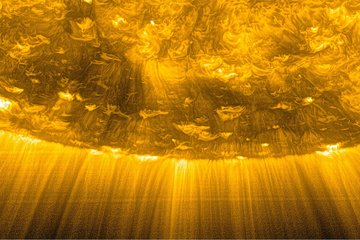Mercury Plasma Environment
A Bepi Colombo Mission to Mercury project (DLR funding)
The Bepi Colombo Mission to Mercury is a joint project of the European Space Agency ESA and its Japanese counterpart JAXA. The mission was launched in October 2018 and will inject two spacecraft into orbit around the innermost planet in our solar system:
- the Mercury Planetary Orbiter (MPO) provided by ESA and
- the Mercury Magnetospheric Orbiter (MIO) provided by JAXA
The mission will for the first time provide two-point measurements in the vicinity of Mercury. The two spacecraft will explore the interior and the surface of the planet itself, its tenuous atmosphere (exosphere) and its magnetosphere.
The Planetary Plasma Environment group at MPS has a strong heritage in the exploration of planetary magnetospheres and space plasma interactions throughout the solar system. It has contributed instruments to several past and present missions that flew by or orbited for example Jupiter and Saturn ). The group participates in the Bepi Colombo mission by contributing hardware and scientific expertise to two of the plasma instruments: (1) The Planetary Ion Camera (PICAM) on board MPO which is an imaging mass spectrometer for planetary ions and (2) the Mass Spectrum Analyzer MSA which is part of the Mercury Plasma Particle Experiment on board MIO. Both particle instrument packages aim at mapping the neutral and charged particle environment of Mercury’s exosphere and magnetosphere.
The first scientific measurements in the vicinity of Mercury were successfully collected with the Bepi Colombo instruments during three flybys at the planet in 2022 and 2023. After injection into separate Mercury orbits, both spacecraft will continuously investigate the planet’s plasma environment beginning in early 2026.
In preparation of the upcoming scientific investigations of Bepi Colombo and given the increased interest in the investigation of the planet’s magnetosphere and exosphere, the Planetary Plasma Environment Group is offering a PhD project with the following possible topics:
- The plasma particle environment of Mercury: average state and dynamics
- The release and transport of helium and possibly sodium ions from Mercury’s surface throughout the magnetosphere, including the capture and dynamics of interstellar helium in the magnetosphere
- Comparative magnetosphere/radiation belt studies (Mercury vs. Earth)
The project allows PhD topics in three different research branches dependent on the background of the candidates:
- Analysis and interpretation of existing data from the former MESSENGER mission to Mercury and data from the first flybys of BepiColombo at Mercury.
- Numerical simulation of the plasma interaction between the Mercury surface, the magnetosphere and the solar wind or development of respective photo-chemical models.
- Re-calibration of laboratory copies of plasma instruments flying on the BepiColombo mission to support the observations, including development of software to control the calibration setup.











